Peanut Disease Control Programs and Advisories Begin in Early July
go.ncsu.edu/readext?417524
en Español / em Português
El inglés es el idioma de control de esta página. En la medida en que haya algún conflicto entre la traducción al inglés y la traducción, el inglés prevalece.
Al hacer clic en el enlace de traducción se activa un servicio de traducción gratuito para convertir la página al español. Al igual que con cualquier traducción por Internet, la conversión no es sensible al contexto y puede que no traduzca el texto en su significado original. NC State Extension no garantiza la exactitud del texto traducido. Por favor, tenga en cuenta que algunas aplicaciones y/o servicios pueden no funcionar como se espera cuando se traducen.
Português
Inglês é o idioma de controle desta página. Na medida que haja algum conflito entre o texto original em Inglês e a tradução, o Inglês prevalece.
Ao clicar no link de tradução, um serviço gratuito de tradução será ativado para converter a página para o Português. Como em qualquer tradução pela internet, a conversão não é sensivel ao contexto e pode não ocorrer a tradução para o significado orginal. O serviço de Extensão da Carolina do Norte (NC State Extension) não garante a exatidão do texto traduzido. Por favor, observe que algumas funções ou serviços podem não funcionar como esperado após a tradução.
English
English is the controlling language of this page. To the extent there is any conflict between the English text and the translation, English controls.
Clicking on the translation link activates a free translation service to convert the page to Spanish. As with any Internet translation, the conversion is not context-sensitive and may not translate the text to its original meaning. NC State Extension does not guarantee the accuracy of the translated text. Please note that some applications and/or services may not function as expected when translated.
Collapse ▲Programs to prevent and control early (Figure 1) and late leaf spots (Figure 2) will begin soon. In well rotated fields, the first fungicide spray for leaf spot control should be applied when peanuts reach R3. This is when about half the plants in a particular planting have at least one pod starting to develop. Spray programs can be delayed by two weeks (R3+2) on the cultivar Bailey, which has moderate partial resistance to leaf spots. Reapply foliar fungicides every two weeks, or follow the Peanut Leaf Spot Advisory after the first spray.
The North Carolina Peanut Leaf Spot Advisory is a cooperative effort by the State Climate Office of North Carolina and the Department of Plant Pathology at NC State University. The advisory is a safe way to minimize fungicide applications by spraying only when weather conditions favor disease.
We also provide spray advisories to warn growers that weather conditions favor development of Sclerotinia blight (Figure 3). Sprays for Sclerotinia blight control are necessary only in fields with a history of disease. Due to favorable weather in many parts of the state, growers should start scouting for Sclerotinia blight now. Once rows are within 6 inches of closing, follow advisories to determine whether conditions are right for disease development.

Figure 2. Late leaf spot. Spots seen on the underside of the leaf are dark brown and may have spores. Note that some spots have halos.

Figure 3. Sclerotinia blight usually is first seen as fluffy growth on stems, pegs or leaves. Infected areas often are bleached.
Leaf spot and Sclerotinia advisories are delivered by daily emails throughout the summer. Contact Barbara Shew or your County Extension Office if you would like to receive peanut disease advisories. Advisories are also available on-line at http://ncsupeanut.blogspot.com/
For more information about peanut diseases, see 2016 Peanut Information



